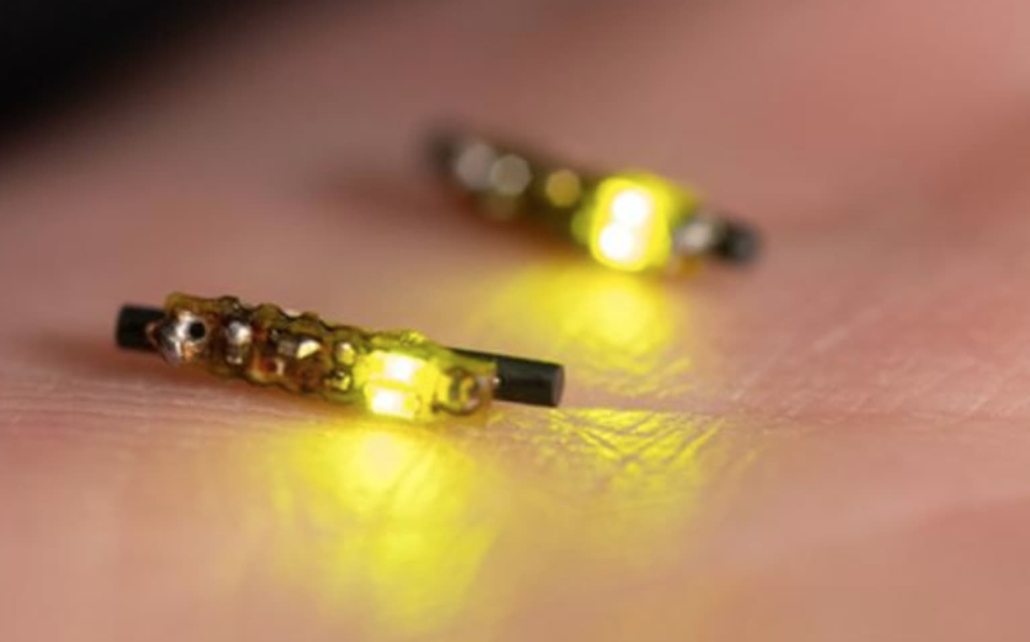Implantable wireless LED device shown to treat deep-seated cancers with photosensitising dye
A novel miniature wireless LED device developed by researchers at the University of Notre Dame demonstrates potential for treating deep-seated cancers through a combination of photodynamic therapy (PDT) and immune system activation. The implantable device, when used in conjunction with the photosensitising dye Rose Bengal, not only destroys cancer cells but also stimulates an immune response against the tumour.
Photodynamic therapy has long been recognised as an effective, minimally invasive treatment for cancers located on or near the skin. However, its application to deep-seated cancers has been limited by the inability of light to penetrate deep into tissues. The new wireless LED device aims to overcome this limitation by bringing light directly to the tumour site.

This miniature, implantable LED device fights cancer with light.
Device design and mechanism of action
The research team, led by Bradley D. Smith and Thomas D. O’Sullivan, has developed one of the smallest prototypes to date, with a volume of just 23 cubic millimetres. “Our device is small enough to be injected into biological tissue using a standard biopsy syringe,” explained O’Sullivan, associate professor of electrical engineering and co-author of the study.
The device consists of a printed circuit board, a helical copper-wound ferrite-core antenna, two green LEDs emitting light at 573 nm, and an impedance matching network. It is powered wirelessly by radiofrequency (RF) energy and can operate effectively even when buried in tissue and located up to 6 cm from the transmitting antenna.
Photosensitisation and cell death mechanism
The researchers chose green light (573 nm) to closely match the excitation wavelength of Rose Bengal, a highly efficient oxygen photosensitiser. “Rose Bengal is an FDA-approved vital dye that has been used clinically for more than three decades in diagnostic ophthalmology procedures,” noted Smith, the Emil T. Hofman Professor of Science and co-author on the paper.
When the device is activated, Rose Bengal absorbs the light energy and transfers it to nearby oxygen molecules, creating reactive oxygen species that can trigger cell death. Interestingly, the team observed evidence of pyroptosis, a highly inflammatory form of programmed cell death that can trigger a robust immune response.
Promising results in cell culture studies
The team conducted studies using HT-29 colorectal adenocarcinoma cells treated with a cell-permeable form of Rose Bengal called Rose Bengal Diacetate. They observed significant cell death following light exposure from the wireless device.
“Our microscopy studies revealed distinctive morphological changes in the treated cells, including the formation of large bubble-like protrusions, which are hallmark features of pyroptosis,” said Hailey S. Sanders, a biochemistry graduate student and co-first author of the study.
Future directions and potential applications
While these initial results are promising, the researchers emphasise that further studies are needed to fully understand the potential of this approach. “Our goal is not necessarily to kill all tumour cells directly, but rather to convert an immune-silent tumour into an immunogenic one by stimulating the activation and recruitment of immune cells,” explained Smith.
The team envisions potential applications in neoadjuvant therapy, where the implanted device could trigger an immune response capable of attacking distant cancer sites. Additionally, the technology could be adapted for use with longer-wavelength photosensitisers, allowing for deeper light penetration through tissue.
Implications for cancer treatment
The development of this implantable wireless LED device could potentially provide a new, relatively easy, way to treat some deep-seated cancers. However, quite a bit scientific work still needs to be done. The long-term efficacy and safety of this approach will first have to be tested in animal models and, eventually, in human clinical trials. However, looking at the efficacy of this technology in killing cancers on or near the skin, it does appear hopeful that it may also serve as a potentially powerful new deep-seated cancer treatment.
Reference:
Rho, S., Sanders, H. S., Smith, B. D., & O’Sullivan, T. D. (2024). Miniature wireless LED-device for photodynamic-induced cell pyroptosis. Photodiagnosis and Photodynamic Therapy, 47, 104209. https://doi.org/10.1016/j.pdpdt.2024.104209

